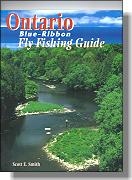The Blue-Ribbon Grand - Part 3
By Scott E. Smith
Like any catch-and-release fishery, once the fish reach larger sizes they have
likely been caught or hooked before, and for sure have seen their share of
feathered hooks. This brings other challenges into play if you are after larger
fish. Light tippets, small flies and quick reflexes are in order. Size 12 to 18
nymphs are standard on 4X tippets, while dry flies are generally fished on
twelve-to-twenty-foot leaders tapering to 5X or 6X. While nymphing the river
I no doubt missed ten fish to every one I hooked. The takes are subtle - especially
from the larger fish. I learned volumes on nymphing techniques by watching
John Valk work the water. He uses his own style of nymph fishing and hooks
far more fish than anyone I've fished with. Using an indicator of Biostrike, John
fishes small nymphs on a short length of leader below the indicator. His use of
added shot is very conservative, even in the faster runs. This is because of how he
continually mends and manipulates his line to reduce drag. He uses long rods and
carries them in a high position throughout the drift. The key to his hooking success
is his inherent ability to keep the line in continual control - keeping a tight line
without speeding up the drift - and pulling the trigger on the slightest hesitation or
movement of the indicator. One might assume that many of these movements
are weeds or bottom, but in closely watching John fish, I soon noticed that he
was fishing considerably less line below his indicator than the total depth of
the run. He was still fishing near bottom, but not on bottom. There is a marked
difference between the two. If you are fishing too much added weight or too
much leader below the indicator, you will be continuously hung up on weeds
and rocks, and ultimately spend most of your time rigging instead of fishing.
The most common rod weight used on the Grand is a 4-weight/nine-footer.
Lighter rods will certainly handle the small flies and light tippets required here,
but the large size of the Grand's brown trout dictates a good quality four-weight.
I used a Sage 3 light-line, 4-weight nine-foot rod and found it just right for the
fish, and the moderated casting distances required. If you are going to fish
streamers, however, a six-weight would be a better choice.
During my trip to the Grand, John took me to the same favourite haunts that
his partner Barney Jones took Jim and Kelly Watt for the production of their
video on the Grand river. John made a point of showing me exactly where
he hooked and landed a whopping twenty-seven-inch, eight-pound brown in
the trestle-area in Section 2. John adds that this fish has been caught both
before and after that successful outing. A twenty-five-inch brown was hooked
and lost by Kelly Watt during the making of their Grand River video in this
same pool. Numerous fish in this size class - and bigger - are in the river.
The largest fish landed, to John's knowledge, was a twelve-pound football
taken from just below Shand Dam (upstream from Section 1 of the no-kill).
This behemoth had been hooked numerous times, but always snapped off
after a brief tussle. The size and proportions of this fish were likely attributed
to the area in which the fish took up residency; continuously grazing on
baitfish and insects that came churning through the turbines at the dam.

As for numbers of fish, no recent electro-fishing has been done, so accurate
counts on the population are not available. From my own experience I can
tell you that there are plenty. Warren Yerex of GRCA estimates that there
are approximately 3000 brown trut per mile throughout the special regulations
stretch. This is a raw estimate based on mathematics; 220,000 fish stocked
in the last ten years with a 60% mortality rate. Whatever the actual number
is, there are quite obviously abundant populations in certain portions of this
tailwater stretch.~ Scott E. Smith
Next time Hatches and Flies!
From: Ontario Blue-Ribbon Fly Fishing Guide.We thank
Frank Amato Publications, Inc. for re-print permission!
|



